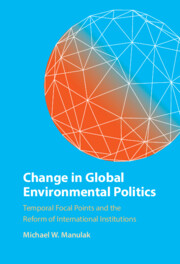 Change in Global Environmental Politics
Change in Global Environmental Politics Book contents
- Change in Global Environmental Politics
- Change in Global Environmental Politics
- Copyright page
- Dedication
- Contents
- Figures and Tables
- Acknowledgments
- Abbreviations
- 1 Introduction
- 2 It’s About Time
- 3 The Stockholm Conference and Institutional Change
- 4 UNEP and the 1982 Nairobi Conference
- 5 The Brundtland Commission and the Seeds of Change
- 6 The Rio Conference and Institutional Change
- 7 Post-UNCED UN Environmental Institutions
- 8 Conclusion
- Bibliography
- Index
5 - The Brundtland Commission and the Seeds of Change
Published online by Cambridge University Press: 12 May 2022
- Change in Global Environmental Politics
- Change in Global Environmental Politics
- Copyright page
- Dedication
- Contents
- Figures and Tables
- Acknowledgments
- Abbreviations
- 1 Introduction
- 2 It’s About Time
- 3 The Stockholm Conference and Institutional Change
- 4 UNEP and the 1982 Nairobi Conference
- 5 The Brundtland Commission and the Seeds of Change
- 6 The Rio Conference and Institutional Change
- 7 Post-UNCED UN Environmental Institutions
- 8 Conclusion
- Bibliography
- Index
Summary
This chapter focuses on the environmental diplomacy surrounding the World Commission on Environment and Development, popularly known as the “Brundtland Commission.” This process popularized the concept of sustainable development. The chapter begins by detailing the substantial changes seen in international environmental conditions through the mid-1980s, brought about largely by the Third World Debt crisis. These shifts created a rapidly deteriorating global environmental context and necessitated significant changes in institutional arrangements. The need for institutional change was a central finding of the important 1987 “Brundtland report,” titled Our Common Future. The Brundtland Commission highlighted a rapid deterioration in the world environment and underlined the need for major institutional change. Some actors sought to realize such change at the United Nations General Assembly in 1987, when the report and its call for action were presented to world leaders. Coordination was hindered, however, by divergent expectations and the absence of a Temporal Focal Point. While states were incentivized to cooperate rapidly to address problems in global environmental governance, the institutional status quo prevailed.
Keywords
- Type
- Chapter
- Information
- Change in Global Environmental PoliticsTemporal Focal Points and the Reform of International Institutions, pp. 139 - 175Publisher: Cambridge University PressPrint publication year: 2022
- 1
- Cited by


